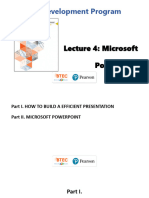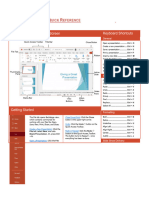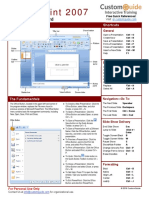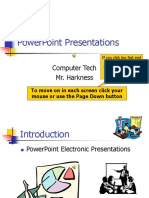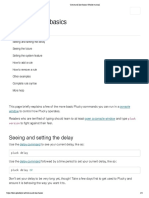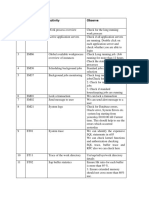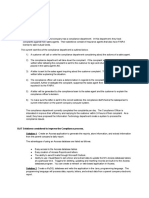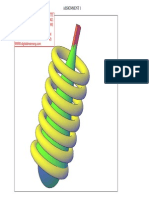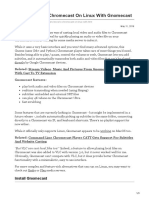0% found this document useful (0 votes)
22 views5 pagesMS Word and MS
B
Uploaded by
jaylujamis92Copyright
© © All Rights Reserved
We take content rights seriously. If you suspect this is your content, claim it here.
Available Formats
Download as DOCX, PDF, TXT or read online on Scribd
0% found this document useful (0 votes)
22 views5 pagesMS Word and MS
B
Uploaded by
jaylujamis92Copyright
© © All Rights Reserved
We take content rights seriously. If you suspect this is your content, claim it here.
Available Formats
Download as DOCX, PDF, TXT or read online on Scribd
/ 5
CONTROL KEY SHORTCUTS
CTRL+A= All Select CTRL+ S= Save
CTRL+B= Bold CTRL+ T= New Tab
CTRL+ C= Copy CTRL+ V= Paste
CTRL+ D= Duplicate CTRL+ W= Close The Window
CTRL+ E= Allignment center side CTRL+ X= Cut
CTRL+F= Find CTRL+ Y= Redo
CTRL+ G= Group and go to CTRL+ Z= Undo
CTRL+ H= Replace CTRL+ Esc= Window Start Menu
CTRL+ I= Italic CTRL+ Tab= Switch between open
CTRL+ J= Justify tabs in browsers or other tabbed
CTRL+ K= Hyperlink programs
CTRL+ L= Alignment Left Side CTRL+ Shift+ Tab= Will go
CTRL+ M= New Slide backwards (right to left)
CTRL+ N= New Document CTRL+ Delete= Delete next word
CTRL+ O= Open CTRL+ → = Next word
CTRL+ P= Print CTRL+ Alt+ ← = Restart X11
CTRL+ Q= Quit CTRL+ Alt+↑= Rotate screen
CTRL+ R= Alignment Right Side right-side
CTRL+ PgDn= Next Tab CTRL+ Alt+↓=Rotate screen upside
CTRL+ PgUp= Previous Tab down
CTRL+ ← = Previous word CTRL+ Alt+← = Rotate screen left
Alt+ 0241= ñ CTRL+ Alt+→ = Rotate screen
Alt+ 0209= Ñ right
Shift+ f3- Capitalization
Guide: Using Microsoft Word to
Create Report
✅ PART 1: Open Microsoft Word
Start the application:
1. Click the Start Menu (Windows icon), then type "Microsoft Word" and press
Enter.
Create a new document:
1. Click on Blank Document to start from scratch.
2. Alternatively, you can select a Report Template under the search bar by typing
“report.”
✅ PART 2: Creating the Report
Step 1: Add Title
Click the top part of the page and type your report title.
Highlight it → go to the Home tab → adjust:
Font style (e.g., Times New Roman, Calibri)
Font size (e.g., 16–24 pt for titles)
Bold, Center alignment, etc.
Step 2: Insert Your Name and Details
Press Enter under the title and add:
i. Your name
ii. Date
iii. Subject or class (if needed)
Step 3: Start Writing the Content
Use paragraphs for each section (introduction, body, conclusion).
Use bullet points or numbering for lists:
Go to Home → choose the bullet or number icon.
Step 4: Use Headings and Formatting
Highlight section titles (e.g., Introduction, Findings, Conclusion)
Go to the Styles group on the Home tab and choose Heading 1, Heading 2, etc.
This helps in making a Table of Contents later.
✅ PART 3: Adding Elements
Add Pictures:
1. Go to Insert tab → Pictures
2. Choose This Device, select an image, then click Insert
3. Resize and move it as needed
Add Table:
1. Go to Insert → Table
2. Choose how many rows and columns
3. Fill it with data
Add Page Numbers:
1. Go to Insert → Page Number
2. Choose top or bottom position (e.g., Bottom of Page → Plain Number 2)
Add Spacing in between lines
1. Highlight the lines in your report where you want to add space.
2. Click the line spacing icon and choose the number of space you want to add.
3. If ever the space you want to add is 1.0 or 2.0, you cant just directly click CTRL +
1 or CTRL + 2 after you highlight the lines.
Add Table of Contents (optional):
1. Place your cursor at the beginning
2. Go to References → Table of Contents
3. Choose a style (Automatic Table 1 or 2)
✅ PART 4: Saving the Report
To Save as a Word Document (.docx):
1. Click File (top-left corner)
2. Click Save As
3. Choose location: This PC, Desktop, etc., where you want to save your file.
4. Enter file name
5. Save as type: Word Document (.docx)
6. Click Save
To Save as PDF:
1. Click File → Save As
2. Under Save as type, choose PDF
3. Click Save
4. If ever you are using WPS office in your laptop, click the Menu on the upper left
corner of the screen, and you may directly click “export to PDF”
✅ PART 5: Printing or Sharing
To print:
1. Click File → Print → Select printer → Click Print
To share:
Go to File → Share
1. Choose Email → Send as attachment
2. Or upload to OneDrive and send the link
Guide: Using Microsoft PowerPoint
to Create Presentations
PART 1: Open Microsoft PowerPoint
1. Open the app: Click the Start Menu → Type "PowerPoint" → Press Enter.
2. Create a new presentation: Click Blank Presentation or choose a template.
PART 2: Understanding the Interface
Key Tabs and What They Do:
Home: Add slides, basic formatting
Insert: Add images, videos, charts
Design: Choose themes and slide styles
Transitions: Add slide animation when changing slides
Animations: Add animation to text or objects
Slide Show: Start or set up presentation
File: Save, print, export
PART 3: Creating Your Presentation
Step 1: Create Title Slide
- Click the boxes to type: Title and Subtitle (e.g., your name, date, subject)
Step 2: Add New Slides
- Go to Home → New Slide, choose a layout, and add content
Step 3: Insert Pictures, Videos, Charts
- Click slide → Insert → Pictures or Video → Select file → Resize/move
Step 4: Apply a Design Theme
- Go to Design tab → Choose theme → Use Variants to customize
Step 5: Add Transitions Between Slides
- Go to Transitions → Choose effect → (Optional) Click Apply to All
Step 6: Add Animations
- Select object → Animations tab → Choose animation → Use Animation Pane
PART 4: Slide Show & Preview
- Go to Slide Show tab → Click 'From Beginning' or press F5 to preview
- Use arrow keys to move between slides; Esc to exit slideshow
PART 5: Saving Your Presentation
To Save as PowerPoint (.pptx):
- File → Save As → Choose location → Enter file name → Save as type: PowerPoint
Presentation (*.pptx)
To Save as PDF:
- File → Save As → Save as type: PDF → Click Save
PART 6: Printing or Sharing
To Print:
- File → Print → Choose layout (Full Page, Handouts) → Click Print
To Share:
- File → Share → Email as PowerPoint or PDF, or upload to OneDrive and send a
link
Useful Keyboard Shortcuts
- Ctrl + M: New Slide
- F5: Start Slide Show
- Ctrl + S: Save
- Right-click slide → Duplicate Slide: Duplicate Slide
- Insert → Text Box: Add text box



